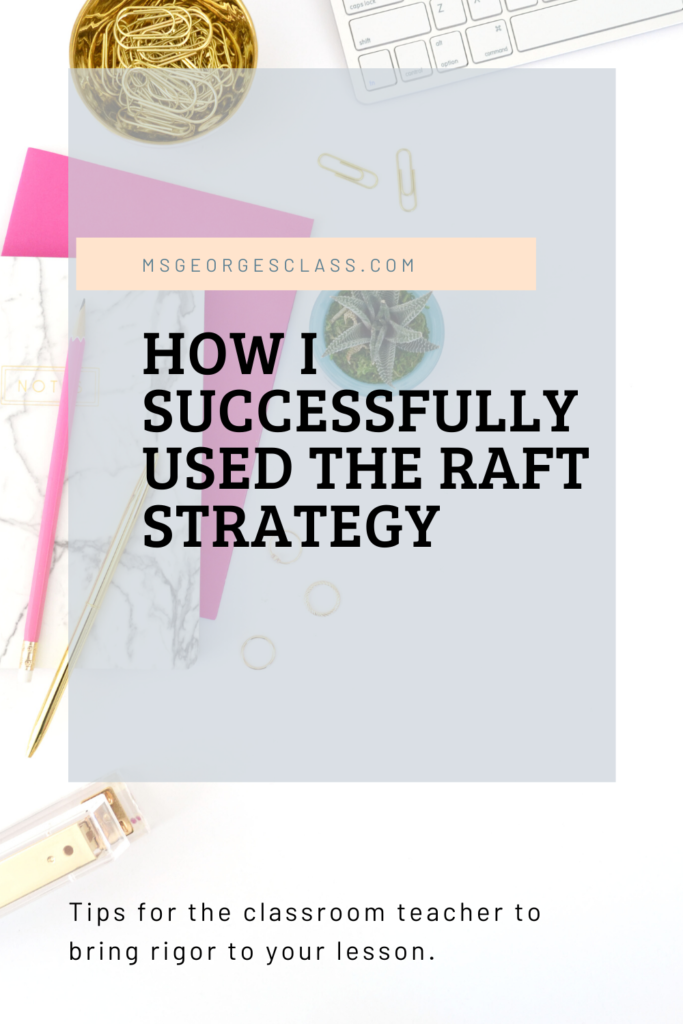
RAFT strategy? What is that? It is a strategy that can be used in any subject area. RAFT stands for Role/Audience/Format/Topic, and writing from this aspect will provide students the opportunity to write from a perceptive that shows a better understanding and a higher level in their writing (Blackburn 56). I read about this strategy while reading Rigor Is Not a Four-Letter Word by Barbara R. Blackburn. I immediately used this strategy in the fall with my career exploration classes, and students were engaged and able to complete the task. I used this strategy again with my spring career exploration classes, and students were eager to begin this strategy. The RAFT strategy is a great strategy to assess the student’s knowledge of the lesson you taught.
Last fall, I instructed the whole class that they were to prepare a brochure on the topic of stress and how to relieve stress for high school students. Their role was a high school counselor developing a brochure for 8th-9th grade students. I showed them a model of what was expected and a rubric. Students had two class periods to complete the tasks and were allowed to use articles and worksheets we used for the topic of stress. This strategy worked well. The information was correct and informative. One negative was the design of the brochure. I work at an art school, and many of the artists are perfectionists. Although they were given two days and encouraged to work on it at home, they did not finish the artwork.
This semester, I deleted the artwork for the RAFT strategy. Last week, I posted five RAFT worksheets around the classroom. Students were instructed to write a 75-word speech or letter about work ethic skills. They were given a rubric for this assignment and discussed the expectations for this assignment in a think-pair-share mode. I gave students three minutes to walk around the classroom and decide on their RAFT assignment. I was impressed and shocked by the engagement of the students. Students quickly chose an assignment and began writing. Students were discussing which RAFT was better and they started working. Each class was given 15 minutes to write and instructed to finish it over the weekend.

| Role | Audience | Format | Topic |
| Student | Magnet Director | Letter | Write about how well students demonstrated the 7 As of work ethic. |
| Parent or Teacher | Student | One-minute Speech | Praising a student about how well they demonstrated the 7 As of work ethic. |
| Citizen | City Council Board | One-minute Speech | The importance of keeping career exploration in high schools and how it benefits the community. |
| Fast Food Manager | Fast Worker | One-minute Speech | Praising a worker about how well they demonstrated the 7 As of work ethic. |
| Volunteer | School Administration | One-minute Speech | Praising a student about how well they demonstrated the 7 As of work ethic. |

I walked around the room to observe students working, and most of the students chose to be the parent or teacher. The students were adding the 7 As of work ethic skills (attitude, attendance, appearance, ambition, acceptance, appreciation, and accountability) and explaining each skill. According to Blackburn, “when students are asked to write for a genuine purpose and audience, they tend to complete the assignment more effectively” (56). I witnessed passion when they were writing because they decided their role and what they wanted to express when writing about the 7 As. In each class, I gave the opportunity for four-five students to read their RAFT aloud. I was impressed by how they wrote from their roles. Not only did I provide rigor to the assignment, but also differentiation instruction. Students chose the area where they were strong and were able to produce successful pieces. Also, students were writing more than 75 words because they knew they would write more and elaborate on the topic.
In conclusion, the RAFT strategy provides rigor and differential instruction because students are able to show what they know and write to an authentic audience. This strategy can be used for every subject, including math. I saw a math teacher making copies of a RAFT form for her class. My students appeared to be more engaged and eager to write from a different perspective. I asked my students if they had ever completed a RAFT, and they quickly said no and continued to work on their assignment. It’s those moments that make me passionate about students learning and teaching.
Work Cited
Blackburn, Barbara R. Rigor Is Not a Four-Letter Word. 2nd ed., Routledge, 2012.




Leave a Reply